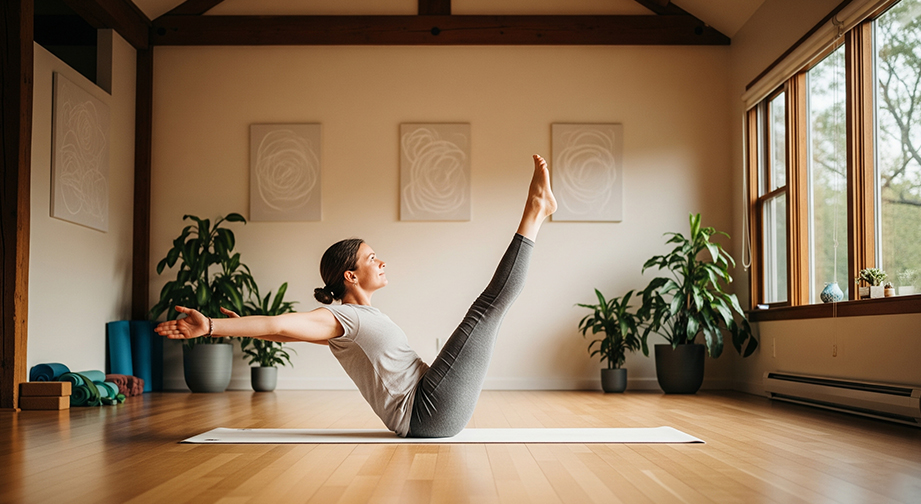Navasana / Naukasana (Boat Pose): Your Guide to Core Strength and Balance
Introduction
Navasana, also known as Naukasana or Boat Pose, is a beginner-friendly sitting yoga posture that fires up the core and cultivates balance. In Sanskrit, “Nava” means boat, and “asana” means pose. The very essence of Boat Pose is energizing — it awakens your inner strength and stability.
If you’ve ever felt sluggish or achy after long hours sitting at a desk, Navasana can be your go-to move for waking up your body, improving posture, and reconnecting with your breath.
Step-by-Step Guide to Practicing Navasana (Naukasana)

- Sit upright on your mat with your legs extended straight in front of you, hands at your sides.
- Bend your knees and place your feet flat on the floor. Lengthen your spine and sit tall.
- Place your hands behind your knees for support. Lean back slightly, keeping your back straight and chest open.
- Inhale deeply, then, as you exhale, engage your core and gently lift your feet off the ground, shins parallel to the floor (like a tabletop position).
- If comfortable, release your arms and extend them parallel to the floor, palms facing each other.
- For the full posture, try straightening your knees so your body forms a “V” shape while balancing on your sit-bones. (It’s OK to keep knees bent!)
- Keep steady breathing:
- Inhale: Lengthen your spine, lifting the chest.
- Exhale: Engage your core and maintain balance.
- Hold for 15–30 seconds (or 3–5 breaths). Repeat 2–3 rounds as you build strength.
Modifications for Beginners:
- Keep knees bent and hands holding the backs of your thighs.
- Practice with just one leg lifted at first.
- Sit on a folded blanket to lift the hips for more ease.
Intensifications for Advanced Practitioners:
- Straighten legs fully and reach arms overhead or out to the sides.
- Add a twist: clasp hands and rotate torso slowly left/right.
- Hold for longer, up to 1 minute.
Alignment & Safety Tips
- Spine: Keep the back straight and chest broad — avoid rounding the spine.
- Core: Draw belly in, engaging the lower abdominal muscles.
- Neck: Keep the gaze soft and forward, not straining the neck.
- Shoulders: Relax away from ears to avoid tension.
Common Mistakes & How to Avoid:
- Avoid collapsing chest or rounding spine — always lift through the sternum.
- Don’t lock the knees: micro-bend if legs are straight.
- If balance is tricky, keep hands on the floor beside hips or behind knees.
Safety Precautions:
- Avoid if you’re pregnant, have recent abdominal, neck, or lower back injuries.
- Stop if you feel pain or strain (core engagement should feel strong, not painful).
Benefits of Navasana (Naukasana)
Physical Benefits:
- Builds core strength (abs, hip flexors, lower back)
- Tones the thighs and improves posture
- Strengthens the spine and improves balance
Mental Benefits:
- Relieves stress through focused breathing
- Improves concentration and presence
- Boosts confidence through mastery of balance
Energy / Chakra Connection:
- Stimulates the Manipura Chakra (solar plexus) — center of personal power and will
- Helps balance energy, promoting a sense of inner stability
Contraindications
- Avoid Boat Pose if you have:
- Pregnancy
- Recent abdominal, spinal, or hip injury/surgery
- Severe lower-back pain or hernia
- Heart conditions (consult your doctor first)
- Safe alternative: Try Half Boat Pose (Ardha Navasana) or Legs on Chair Pose for gentle core engagement.
Beginner’s Tips & Variations
- Props:
- Place a yoga block between the thighs to activate inner legs.
- Use a strap looped around feet for arm extension support.
- Sit at a wall with your back gently touching for upright posture.
- Gentle Variations:
- Lift one leg at a time (“half boat”) to build balance.
- Keep hands on the mat or behind thighs at all times.
- Advanced Variations:
- Straighten legs and reach arms overhead (“full boat”)
- Try “Boat Crunches” — alternating lowering and raising feet
How to Include Navasana in a Yoga Flow
Navasana works beautifully as a main practice or as a core-strengthener in the middle of your class. It helps activate your center and prepares you for balancing or backbending postures.
Pairs well with:
- Adho Mukha Svanasana (Downward Dog)
- Setu Bandha Sarvangasana (Bridge Pose)
- Paschimottanasana (Seated Forward Fold)
Mind-Body Connection
As you balance in Navasana, focus on steady breathing and inner calm. Notice if your mind wobbles as your body does. With regular practice, you’ll build mindfulness and unlock a sense of confidence at your core.
On a deeper level, Boat Pose activates the solar plexus (Manipura) chakra — said to govern your sense of self-worth, willpower, and transformation.
Summary Box
- Asana Name: Boat Pose / Navasana (Naukasana)
- Level: Beginner–Intermediate
- Focus Areas: Core, hip flexors, spine
- Duration: 15–30 seconds / 2–3 rounds
- Best Time to Practice: Morning or evening, on an empty stomach
FAQs
1. Is Boat Pose safe for everyone?
Generally safe for healthy individuals, but avoid if pregnant or dealing with recent core/back injuries.
2. My back hurts in Navasana—what should I do?
Try keeping your knees bent, hands behind thighs, or sitting on a cushion. Focus on core—not just using your hip flexors.
3. How can I progress in Boat Pose?
Build strength gradually. Start with half boat; increase duration and leg extension over weeks.
Reminder: Every body is different. Practice Navasana (Naukasana) mindfully, and celebrate every little bit of progress on the mat!